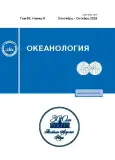Agent-Based Model of Diatom Population Dynamics in Marginal Arctic Seas in Summer
- Авторлар: Fursova P.V.1, Riznichenko G.Y.1, Konyukhov I.V.1, Pogosyan S.I.1
-
Мекемелер:
- Lomonosov Moscow State University, Faculty of Biology
- Шығарылым: Том 63, № 5 (2023)
- Беттер: 773-783
- Бөлім: Морская биология
- URL: https://journals.rcsi.science/0030-1574/article/view/140446
- DOI: https://doi.org/10.31857/S0030157423050040
- EDN: https://elibrary.ru/DDACCT
- ID: 140446
Дәйексөз келтіру
Толық мәтін
Аннотация
A hypothesis is proposed for the functioning of the diatom population under conditions of water column stratification. It is assumed that cells in the upper illuminated water layer accumulate biomass due to photosynthesis. In the lower layer, rich in minerals, the cells replenish their intracellular reserves. Moving from one layer to another allows to cells to compensate for the lack of resources. Sinking occurs as a result of sedimentation, and lifting occurs due to the release of carbon dioxide microbubbles in the process of respiration. On the basis of this hypothesis, an agent model of the population is constructed. The calculations have shown that vertical movements ensure the existence of the population. Various surface illumination make it possible to obtain various distributions of cell numbers in the upper and lower water layers, which is consistent with the data of expeditionary observations.
Негізгі сөздер
Авторлар туралы
P. Fursova
Lomonosov Moscow State University, Faculty of Biology
Хат алмасуға жауапты Автор.
Email: fursova@biophys.msu.ru
Russia, Moscow
G. Riznichenko
Lomonosov Moscow State University, Faculty of Biology
Email: fursova@biophys.msu.ru
Russia, Moscow
I. Konyukhov
Lomonosov Moscow State University, Faculty of Biology
Email: fursova@biophys.msu.ru
Russia, Moscow
S. Pogosyan
Lomonosov Moscow State University, Faculty of Biology
Email: fursova@biophys.msu.ru
Russia, Moscow
Әдебиет тізімі
- Беляев В.И. Кинетическая теория систем, состоящих из макроскопических частиц и ее приложение к задачам экологии. Севастополь: МГИ НАН Украины, 1998. 236 с.
- Демидов А.Б., Шеберстов С.В., Гагарин В.И. Оценка годовой величины первичной продукции Карского моря // Океанология. 2018. Т. 58. № 3. С. 391–403.
- Ильяш Л.В. Жизненные стратегии у морских планктонных микроводорослей / автореферат дисс. … д. биол. н. Москва, 1998 г.
- Крупаткина Д.К., Селивановский Д.А., Стунжас П.А. О регулируемой посредством газовых пузырьков плавучести одной из колониальных форм диатомеи Thalassiosira // Изв. РАН. Серия биол. 1994. № 3. С. 453—461.
- Лелеков А.С., Тренкеншу Р.П. Моделирование динамики азотистых соединений в клетках микроводорослей. 2. Хемостат // Матем. биология и биоинформ. 2019. Т. 14. № 2. С. 450–463.
- Стельмах Л.В., Мансурова И.М. Физиологический механизм выживания динофитовых водорослей в условиях биогенного лимитирования // Биология внутренних вод. 2021. № 2. С. 198–207.
- Стунжас П.А., Сапожников Ф.В. Эти удивительные диатомеи // Природа, 2000, № 5. С. 12–18.
- Флинт М.В., Арашкевич Е.Г., Артемьев В.А. и др. Экосистемы морей Сибирской Арктики. Материалы экспедиционных исследований 2015 и 2017 гг. Москва: Институт океанологии им П.П. Ширшова РАН, 2018. 232 с.
- Шоман Н.Ю. Совместное действие света, температуры и обеспеченности азотом на скорость роста и содержание хлорофилла а у морских диатомовых водорослей / дисс. … канд. биол. наук, Севастополь, 2020, 149 с.
- Экосистемы Карского моря и моря Лаптевых. Экспедиционные исследования 2016 и 2018 гг. М.: Издатель Ерхова И.М., 2021. 368 с.
- BelyaevV.I. Modelling the influence of turbulence on phytoplankton photosynthesis // Ecological Modelling. 1992. V. 60. № 1. P. 11–29.
- Demidov A.B., Mosharov S.A., Makkaveev P.N. Patterns of the Kara Sea primary production in autumn: Biotic and abiotic forcing of subsurface layer // Journal of Marine Systems. 2014. V. 132. P. 130–149.
- Demidov A.B., Gagarin V.I., Vorobieva O.V. et al. Spatial and vertical variability of primary production in the Kara Sea in July and August 2016: the influence of the river plume and subsurface chlorophyll maxima // Polar Biology. 2018. V. 41. № 3. P. 563–578.
- Edwards K.F., Thomas M.K., Klausmeier C.A., Litchman E. Allometric scaling and taxonomic variation in nutrient utilization traits and maximum growth rate of phytoplankton // Limnol. oceanogr. 2012. V. 57. № 2. P. 554–566.
- Goldman J.C., McCarthy J.J. Steady state growth and ammonium uptake of a fast-growing marine diatom1 // Limnol. oceanogr. 1978. V. 23. № 4. P. 695–703.
- Kuznetsov A.G., Konyukhov I.V., Pogosyan S.I. et al. Microfluorimeter for studying the state of photosynthetic apparatus of individual cells of microalgae // Oceanology. 2021. V. 61.P. 1055–1063.
- Litchman E., Klausmeier C.A., Miller J.R. et al. Multi-nutrient, multi-group model of present and future oceanic phytoplankton communities // Biogeosciences. 2006. № 3. P. 585–606.
- Lomas M.W., Baer S.E., ActonS., Krause J.W. Pumped up by the cold: elemental quotas and stoichiometry of cold-water // Diatoms. Front. Mar. Sci. 2019. V. 6. 286.
- Menden-Deuer S., Lessard E.J. Carbon to volume relationships for dinoflagellates, diatoms, and other protist plankton // Limnol. oceanogr. 2000. V. 45. № 3. P. 569–579.
- Muggli D. L., Lecourt M., Harrison P. J. Effects of iron and nitrogen source on the sinking rate, physiology and metal composition of an oceanic diatom from the subarctic Pacific // Marine Ecology Progr. Ser. 1996. V. 132. № 1/3. P. 215–227.
- NetLogo. URL: http://ccl.northwestern.edu/netlogo/ (дaтaogosterne subarctic Pa).
- Parslow J.S., Harrison P.J., Thompson P.A. Saturated uptake kinetics: transient response of the marine diatom Thalassiosira pseudonanato ammonium, nitrate, silicate or phosphate starvation // Marine Biology. 1984. V. 83. № 1. P. 51–59.
- Rhee G.-Y., Gotham I.J. The effect of environmental factors on phytoplankton growth: Temperature and the interactions of temperature with nutrient limitation // Limnol. oceanogr. 1981. 26. № 4. P. 635–648.
- Strzepek R.F., Price N.M. Influence of irradiance and temperature on the iron content of the marine diatom Thalassiosira weissflogii (Bacillariophyceae) // Marine Ecology Progr. Ser. 2000. V. 206. P. 107–117.
- Vedernikov V.I., Demidov A.B., Sud’bin A.I. Primary productionand chlorophyll in the Kara Sea in September 1993 // Oceanology. 1995. 34. P. 630–640.
Қосымша файлдар




















